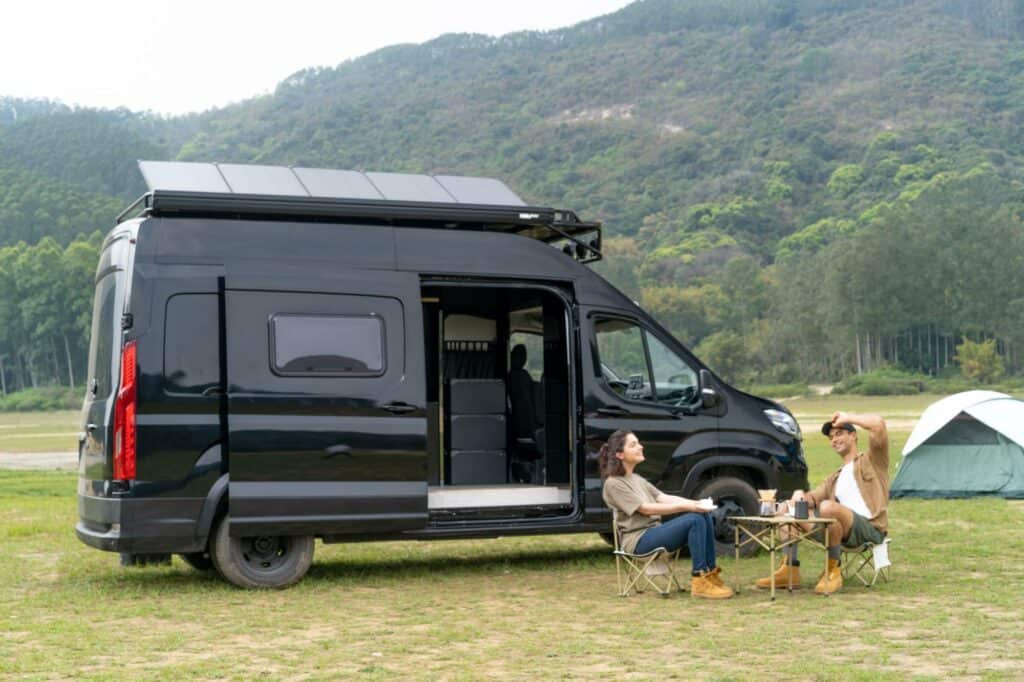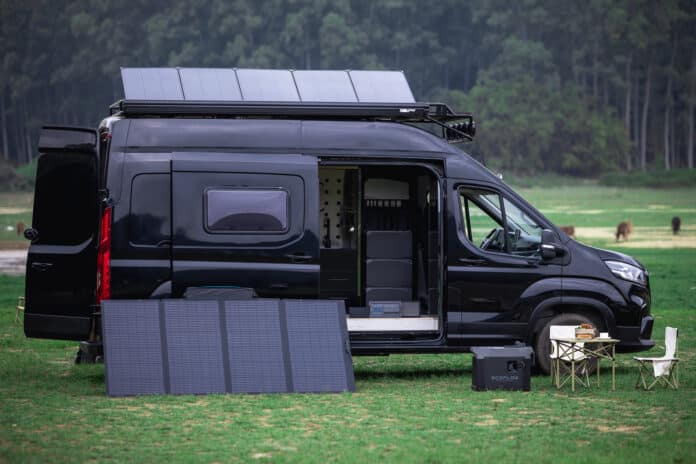There’s never been a better time to explore solar energy, whether you’re heading out for life on the open road or trying to ride out an outage.
Two of the most common solutions are flexible and rigid solar panels. One may be a better fit depending on your energy consumption, available space, budget, and more.
This guide will examine the differences between flexible and rigid panels, their pros and cons, and their uses so you can make the best decision for your energy needs.
What Are the Difference Between Flexible Panels and Rigid Solar Panels?
As the name suggests, flexible solar panels can bend, while rigid ones are stiff to the touch.
Traditional solar panels are constructed with a rigid aluminum case and covered with durable tempered glass, allowing light through and protecting the photovoltaic cells inside. These framing materials create a long-lasting and tough unit that is durable and waterproof. These rigid panels are thick, heavy, and less portable.
Flexible solar panels comprise a combination of monocrystalline cells and laminate, allowing these panels to mold to curved or angled surfaces. They are ideal for boats, RVs, and roofs that can’t accommodate the flat surface required for rigid solar array frames. However, they’re also typically less durable.
What Are the Pros of Flexible Solar Panels?
Flexible panels are useful for applications such as boating, RVs, and campers and outdoor activities like hiking and camping where occasional power is needed. Read on to learn more about their advantages:
Lightweight
Flexible panels weigh about 20% of their rigid counterparts, meaning you can affix them to structures that wouldn’t usually support the weight of a rigid frame. For reference, most flexible panels weigh between four to five pounds, while traditional ones weigh 30 to 50 pounds.
With its lightweight construction, a flexible panel is a practical solution to use in places where weight would affect energy usage. For instance, adding a heavy frame to your RV would add to your total load, increasing your fuel usage. Flexible options can be a more energy-efficient option for motor vehicles.
Flexibility
Depending on the model, flexible PV panels can be bent up at extreme angles, making them ideal for attaching to curved surfaces. They’re ideal for RVs since many have curved roofs, meaning you can attach more of them to maximize your power production.
The EcoFlow 100W Flexible Solar Panel can easily flex up to 258 degrees, which can fit onto a van or RV’s unique shape without affecting solar input.
Ease of Installation
Due to their lightweight characteristics and the ability to bend, flexible panels are easy to install. You install them using adhesive, meaning drilling isn’t required.
That means you won’t need to damage the surface you’re mounting to, making it helpful in installing on your RV or boat.
What Are the Cons of Flexible Solar Panels?
With that said, a few disadvantages are worth noting:
Requires Secure Installation
Due to their lightweight characteristics, flexible panels may fly off on high winds. The lack of mounting brackets means they are less secure than rigid ones.
Reduced Efficiency
Since flexible panels are glued or taped to a surface with adhesive, they don’t have a mounting bracket underneath. The lack of space between the flexible solar panel and the roof means excess heat can build up, damaging the panel and shortening its lifespan.
Overheated photovoltaic cells may lose up to 10-25% of their rated output, making them less efficient.
Shorter Lifespan
The thinner silicone construction makes flexible panels less durable in the long run. Also, rather than being protected by a rigid aluminum frame and heavy-duty glass, they’re attached to flexible laminate, subjecting them to more significant stress over their lifespan.
You can expect flexible panels to last between 5 to 15 years, while rigid ones operate for 25 to 40 years under normal conditions.
What Are the Pros of Rigid Solar Panels?
Made with sturdy tempered glass and protected by anodized aluminum frames, rigid solar panels are best for permanent installations. Let’s look at their advantages:
Longer Lifespan
Rigid panels are made with glass casing and an aluminum frame to protect their solar cells from damage, scratches, or deterioration from the weather. The rugged, corrosion-resistant aluminum framing protects it from outdoor elements such as rain, snow, and wind. As a result, rigid solar panels last up to five times longer than flexible designs.
For example, the EcoFlow 400W Rigid Solar Panel can withstand the harshest weather conditions, including wind speeds of up to 130 mph and snow load of up to 113 lbs. Designed with a robust anti-corrosive aluminum frame and an IP68 waterproof rating, it’ll continue to capture solar power for many years.
Higher Efficiency
Maximizing your solar power production is imperative for powering your needs. Especially during winter, it can be difficult to capture enough sunlight to keep your appliances running.
Rigid panels attach to the roof on top of sturdy mounting brackets, which you can angle to maximize solar gain.
Reliability
Installing a bracket system keeps your solar array secure, ensuring it won’t fly off during high winds. Your installation team orient the array in the optimal position to attract the most sunlight, allowing you to reap the benefits of reduced utility bills and clean, renewable energy.
What Are the Cons of Rigid Solar Panels?
Consider the potential drawbacks of rigid solar panels:
Harder to Install
Installing a permanent panel system requires additional cost and time than a flexible one. Rigid solar panels typically require a racking system, meaning you’ll need to drill the mounting racks onto the surface. You may even need to hire a solar installation expert to help you install and set up your solar panel system.
Costly
Rigid panels tend to cost more than flexible or portable solar panels. The glass casing and aluminum frame add to the price of the material.
Furthermore, you’ll need to buy a mounting bracket system if it’s not included and hire a team of professional installers to help you set it up properly. Even with the government’s Federal Solar Tax Credit and other incentives, the equipment can take a long time to pay off fully.
Heavy
A standard 100W rigid panel weighs about 20 pounds, which can be challenging to transport, especially for outdoor activities like camping or hiking. Also, the heavier weight may not be suited for a weak or damaged roof.

Can You Combine Flexible and Rigid Solar Panels?
If you own an RV or campervan, you likely want to maximize your power production by fitting as many highly-efficient solar panels on your roof as possible. The best way to do so is by combining both flexible and rigid solar panels.
Rigid panels can withstand the outdoor elements as you trek through various terrain in your RV. They also don’t have any heat build-up beneath, which could affect conversion efficiency.
However, adding flexible panels to the curved roof area lets you add more power. Therefore, combining these two-panel types can be highly beneficial.
Using EcoFlow Power Kits, you can combine flexible and rigid solar panels to maximize your power generation capacity. With an MPPT charge controller, you can plug in multiple panels to recharge your battery.
Final Thoughts
Flexible, rigid, and portable solar panels all have their unique benefits. Which option is best for you all depends on your use case. Carefully consider when and where you’ll be deploying your solar panel system. It may even pay to mix and match to cover all your options.
When you’re ready to invest in one or all three designs, shop EcoFlow. Our rigid, portable, and flexible solar panels offer multiple builds and rated power options to generate grid-free power and save on electricity bills.
Frequently Asked Questions
Where you intend to use your solar array will determine whether rigid or flexible panels better suit your needs.
If you own an RV, van, or boat that you use recreationally, flexible panels are the perfect easy-set-up and low-cost option for producing remote power.
If you plan on using solar energy daily for your home or full-time RV life, rigid panels are more durable to sustain you for the long haul. While the initial costs are higher, the durability and longevity of the rigid solar panel make it the wiser choice.
If you’re struggling to decide between low-cost options that you can transport and high-performance options that lack portability, a happy medium could be the EcoFlow Portable Solar Panels. These are lightweight, portable, and made with durable monocrystalline cells for maximum energy absorption. They’re also waterproof, protecting them from outdoor elements.
Some flexible solar panels are less efficient than rigid ones. The lower power density means they capture less sunlight per square inch of the panel.
Also, flexible solar panels use thinner materials and have fewer years of expected lifespan, which reduces their efficiency. Their efficiency decreases if the laminate on flexible solar panels suffers any micro-cracks or other defects due to the thin plastic material.
However, not all flexible solar panels are less efficient. Flexible solar technology has drastically improved recently. Years ago, flexible solar cells were much less efficient than rigid ones. But nowadays, many are just as energy-efficient as their rigid counterparts. Many have between 18 to 22% conversion efficiency.
The EcoFlow Rigid and Flexible Solar Panel both feature a high conversion efficiency rating of 23%, allowing you to charge your home, RV, or campsite in record time.
Also, the EcoFlow Flexible solar panel has integrated bypass diodes to prevent overheating and maintain its efficient cell performance.
Choosing Between Flexible and Rigid Solar Panels
One isn’t necessarily better than the other. Choosing between flexible and rigid solar panels depends on your application.
Flexible panels are cheaper, easier to install, and flexible, making them functional for various mobile applications. Rigid arrays are best suited for permanent solutions where you want to invest in solar for the long term.
